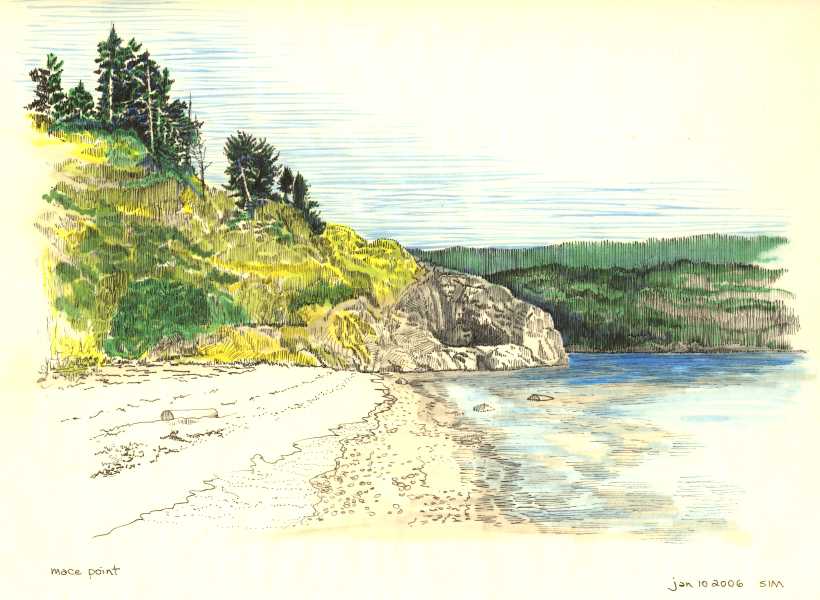
The Maud Rees Sherman watercolour of Mace Point that got me started.
| BRITISH COLUMBIA ARTISTS |

What kind of visual art is included? Typical art forms include painting (oil, acrylic, watercolour, gouache, etc.); drawing (pen, pencil, charcoal, pastel, etc.); printing (relief, woodblock, etching, monoprint, serigraph, digital, etc.); still photography (colour, b&w, film, digital); collage; ceramics; weaving & tapestries; mosaic in glass, tile or other materials; and sculpture or sculptural assemblies in wood, metal, stone, clay, glass, or other materials. Less commonly referenced visual art forms are video, film photography, animation, and performance art.
A few quick technical notes on the web pages:
1. No font is declared in the html, your browser's selected font is what you will see.
2. No background colour or image is declared, you will see what your browser is set to show.
3. All pages will fit to page when printed.
4. Only tables and assorted text formatting (bold, italics, underline, header, center, etc.)
are used in this project.
5. Almost all images are hyperlinked to a web page with information about the image, just click on an image.
6. "Live" web page addresses which are not in this project are listed as text only. Cut and paste into your
browser to visit.
The creation of the project essentially began in 1996 when I (the Editor)
purchased a watercolour painting by artist Maud Rees Sherman.
I began to do research into who she was, and where the scene in the artwork was
painted. I had no idea that over a quarter of a century later I would still be doing research!
I found out that Maud was born in Mission City in 1900, and died in North Vancouver in 1976. She
had a long and distinguished career as a Vancouver artist, exhibiting her work for more than
40 years. The painting was identified as a view of Mace Point on Savary Island,
and I eventually went there and stood on the same spot. Maud's father
Ruiter Stinson Sherman had helped develop the island as a tourist
and summer cottage get-away around 1910, and the family spent many summers on the island.

I had spent quite a bit of time trying to figure out an efficient way to present all of the information. I decided that a web site would be the way to go, and worked out a format that would include all of the major types of information: artist names, exhibition information, information about the organizations who put on exhibitions and ran galleries, newspaper articles and reviews, and publications about art and artists. I wrote a few test web pages starting in December 2002, worked out the kinks, and then started adding files and information. The project expanded rapidly, since I had years of research information already at hand. At this point I was only listing artists who had exhibited work in Vancouver between 1890 and 1950. Each of them had a biography file started when I listed at least one of their artworks in an exhibition. All others were listed in the A to Z index.
In 2007 I began to add images. In 2012 I expanded the original scope of work to include all visual artists who had exhibited work in British Columbia, from the 1700s to the current day. This greatly expanded the number of artists in the index. All of them were added to the A to Z index, with links to exhibitions, publications, and vital statistics. I confess that doing a lot of web page coding and programming is rather boring at times. What kept me going was all of the exciting art history that I was digging up and putting together. I met many interesting people during my research who were helpful and also important in their own way. I developed a cross-country research network of friends who liked to share information. And I kept "looking for Maud" as a parallel research project.


Last but not least, it is impossible for me to list every artist who has ever been active in British Columbia, or who is active today.